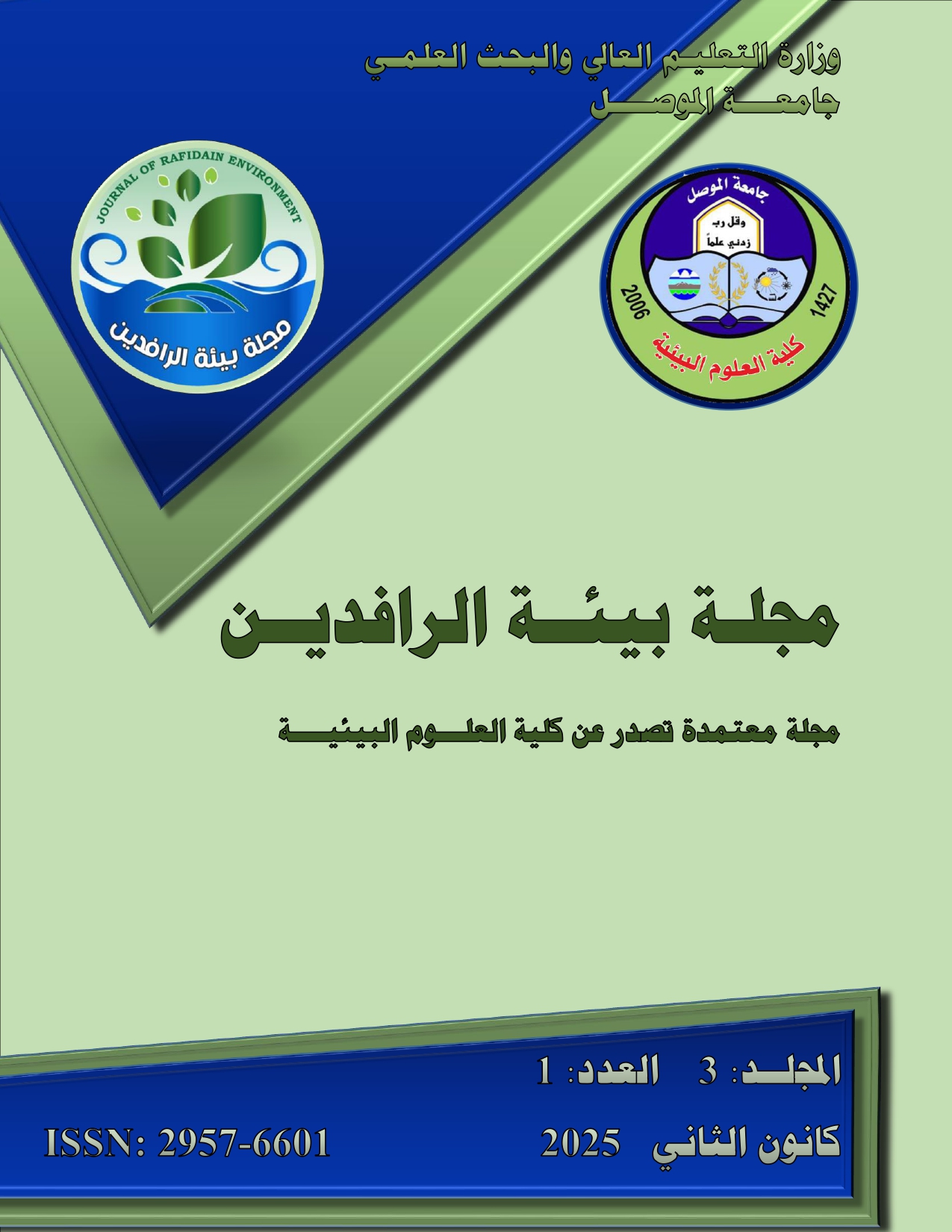Effect of Ultrasound Technology on Organic Pollutants, Electrical Conductivity and pH of Industrial Wastewater from a Tanning Plant in Mosul City

Published
Oct 6, 2025Pages
1-9Abstract
Research has included using ultrasound technology to treat industrial wastewater, which is the final output of the tanning plant in the tannery area before it is discharged into the Tigris River with Mosul City in January 2024. Analyzed chemical oxygen demand (COD), electrical conductivity (EC), and pH for samples. The results of the analyses showed the height that the chemical oxygen demand (1027 mg/L) and electrical conductivity (13014µS.cm-1) are beyond the maximum allowable limits. While the pH was within the standard level before exposure to ultrasound. The results showed a decrease in chemical oxygen demand when exposed to ultrasound, while exposing the sample for the same time increased the (EC), as well as the increased pH values. The efficiency of removing organic pollutants increases with increasing time, starting with (19.08%) at a time of two minutes, and ending at (32.22%) at a time of ten minutes.
References
- Al-Hashemi, Muhammad Ali Ibrahim, Essam Issa Omran, Hassan Ali Omran, 1990. Wastewater treatment. Technical Education Authority, Ministry of Higher Education and Scientific Research.
- Al-Samawi, A.A; Majeed ,N.A; and Shareef, S.F ,2005." Regression analysis for the organic characteristics of Abu_ Ghraib dairy waste water", conferences the first in Babylon University , Environmental search center locally.
- APHA, 1999. Standard methods for the examination of water and waste water. water environment federation, Washington. D. C.
- Buxton, G.V., Greenstock, C.L., Helman, W.P., and Ross, A. B., 1988. Critical review of rate constants for reactions of hydrated electrons, hydrogen atoms and hydroxyl radicals (OH/O−) in aqueous solution. Journal of Physical and Chemical Reference Data, 17:513–886.
- Cheng, J., Vecitis, C.D., Park, H., Mader, B.T., and Hoffmann, M.R., 2010. Sonochemical degradation of perfluorooctane sulfonate (PFOS) and perfluorooctanoate (PFOA) in ground water. Kinetic effects of matrix inorganics, Environmental Science and Technology,44:445–450.
- Cardenas Sierra, R.S.; Zuniga-Benitez, H.; Penuela, G.A., 2021, Elimination of cephalexin and doxycycline under low frequency ultrasound. Ultrason. Sonochem., 79, 105777.
- Dietmar Peters, 2001. Sonolytic of volatile pollutants in natural ground water. Ultrasonics Sonochemistry, 8: 221-226.
- Flint, E.B., and Suslick, K.S., 1991. The temperature of cavitation Science, 253:1397–1399.
- Gelate, P., Hodnett, M., and Zeqiri, B., 2000. Supporting infrastructure and early measurements. National Physical Laboratory Report, Teddington, Middlesex, UK, pp. 2-11.
- Gągol, M., Przyjazny, A. and Boczkaj, G., 2018. Wastewater treatment by means of advanced oxidation processes based on cavitation – A review. Chemical Engineering Journal, 338, pp. 599–627.
- Jinqiu, X., Jinping, J., and Jingwei, W., 2005. Ultrasonic Decomposition of Ammonia Nitrogen and Organic Compounds in Coke Plant Waste water. Journal of the Chinese Chemical Society, 52: 59-65.
- Mason, T.J., 2007b. Sonochemistry and environment-Providing a green_link between chemistry. physics and engineering, Ultrasonic sonochemistry, 14: 476-483.
- Manariotis, I.D., Karapanagioti, H.K. and Chrysikopoulos, C.V., 2011. Degradation of PAHs by high frequency ultrasound. Water Research, 45(8), pp. 2587–2594.
- Mason, T. J., and Lorimer, J. P., 2002, Applied SonoChemistry , Wiley-VCH Verlag GmbH and Co. KGaA.
- Quevauviller, P., Thomas, O. and vander Beken, A., 2006, Waste water Quality Monitoring and Treatment, John Wiley and Sons, Ltd.
- Ritesh, P.; Srivastava, V.C., 2020, Understanding of ultrasound enhanced electrochemical oxidation of persistent organic pollutants. J. Water Proc. Eng., 37, 101378.
- Tony, C., 2009, Tanning Chemistry The Science of Leather, The Royal Society of Chemistry Thomas Graham House UK.
- Vanguard, Abdul Aziz Younis, 1999. The water of the Tigris River is polluted by some industrial and residential waste south of Mosul. Journal of Education and Science, No. 35: 51-59.
- Vega, L.P., Soltan, J. and Peñuela, G.A., 2019. Sonochemical degradation of triclosan in water in a multifrequency reactor, Environmental Science and Pollution Research, 26(5), pp. 4450–4461.
- Ujjaval Mistry and Savan Tank, 2023, COMPARATIVE STUDY OF DYE WASTE WATER TREATMENT WITH USE OF ADVANCED OXIDATION PROCESSES, JETIR, Volume 10, Issue 5.
- Yang, L.; Xue, J.; He, L.; Wu, L.; Ma, Y.; Chen, H.; Li, H.; Peng, P.; Zhang, Z., 2019, Review on ultrasound assisted persulfate degradation of organic contaminants in wastewater: Influences, mechanisms and prospective. Chem. Eng. J., 378, 122146.
- Zhu, Y.; Fan, W.; Feng, W.; Wang, Y.; Liu, S.; Dong, Z.; Li, X., 2021, A critical review on metal complexes removal from water using methods based on Fenton-like reactions: Analysis and comparison of methods and mechanisms. J. Hazard. Mater., 414, 125517.
Identifiers
Download this PDF file
Statistics
Copyright and Licensing

This work is licensed under a Creative Commons Attribution-NonCommercial 4.0 International License.